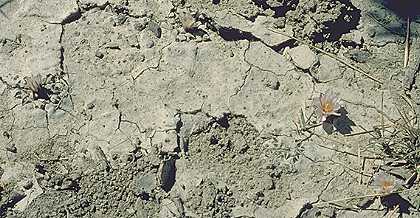Ariocarpus kotschoubeyanus
|

The crown of the plants is flush with the surface of the ground, and it is quite possible (indeed inevitable) that they get walked on (and even driven on) which doesn't seem to harm them at all! |

Location: Tamaulipas
Name: Pata De Venado
The plants of Ariocarpus kotschoubeyanus near Tula are pale flowered (var. albiflorus).
They grow in ground resembling dried mud. The area must be quite wet during the rainy season (Summer). |
The plants of Ariocarpus kotschoubeyanus near Tula are pale flowered (var. albiflorus).
|

An Ariocarpus flower at far right, dwarfed by Echinocactus horizonthalonius. |

You should be able to see 4 plants in flower and (more difficult) at least one not in flower. |

|
A rare slow growing dwarf species that is only 5 cm across when mature. Only discovered in 1840 by Karwinsky von Karvin. These plants were popular in Europe at the time and sold for up to $200, a lot of money back then. Native Indians still use the fine mucilage from this plant as a glue to repair broken pottery. In their native habitat the plants are nearly invisible, half buried in the gravel and are covered in a horny epidermis. These Cacti are characterised by pointed, triangular tubercles, grayish green in color with a felted base. They have a very thick taproot and can be propagated from side shoots. Native to north central Mexico.
This is the easiest of the ariocarpus to flower.
Very slow growing. Need strong sunlight and unrestricted root space. Will tolerate mild cold if kept dry. Propagated from the shoots of older plants.
|

|
A jar of Ariocarpus kotschoubeyanus in alcohol! Apparently used by locals as a painkiller, particularly for blows and bruises. The white at the bottom of the jar is a flower - presumably the plants were collected in flower as they are then much easier to find. We don't think the intention was to take the preparation internally, rather to rub it on the skin. |
Contains: hordenine, N-methyltyramine.
Index





